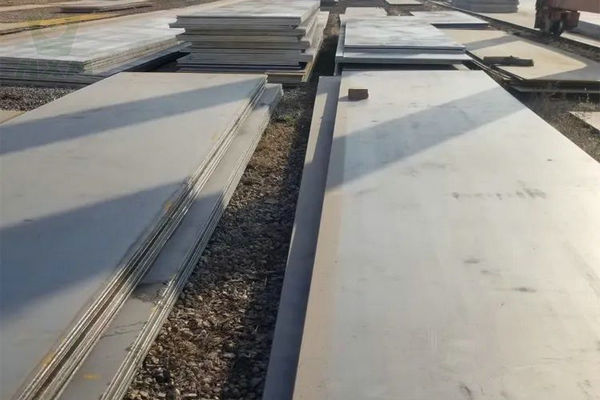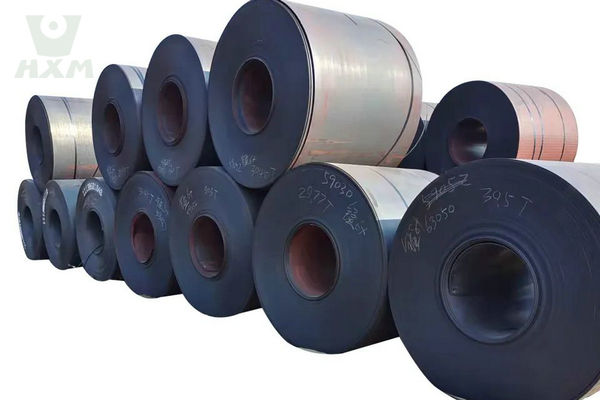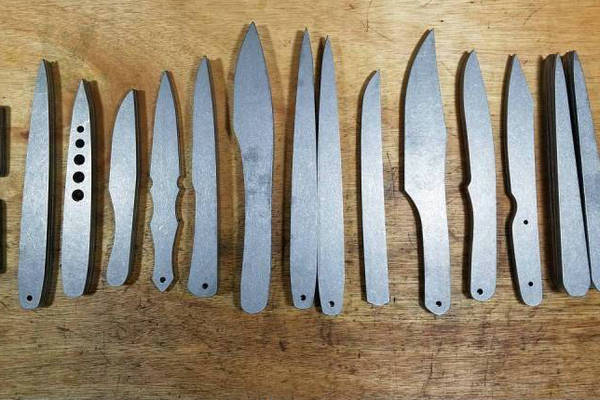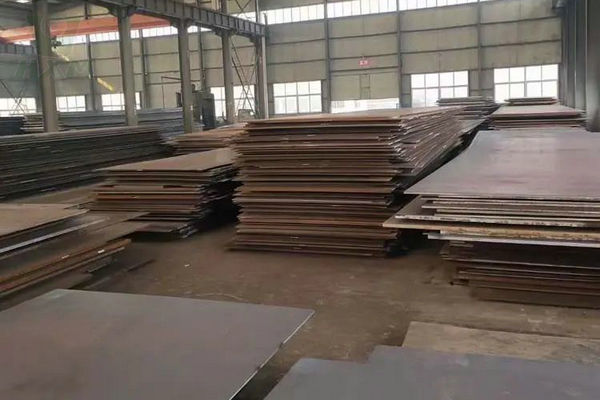AISI 1095 Steel Suppliers and Manufacturer
1095 Steel is a high carbon steel that is widely used for its excellent hardness, edge retention and durability, making it a popular choice for knives, blades and various cutting tools. At Huaxiao Metal, we are one of the trusted 1095 Steel suppliers and manufacturers in China, offering a comprehensive inventory to meet your needs. Our 1095 Steel stock comes in a variety of sizes and thicknesses to ensure timely delivery of your project. We have high quality 1095 Steel for sale, competitive 1095 Steel prices and bulk purchases, please contact us today.
1095 High Carbon Steel Available Products

- Round Bar
- Flat Bar
- Square Bar
- Hexagon Bar
- Plate
- Coil
- Tube
- and More
Please send us specific inquiry details, we will quote for you within 24 hours!
Looking Forward to Becoming One of Your AISI 1095 Steel Suppliers
Table of Contents
What is 1095 Steel?
1095 steel is a type of high carbon steel commonly used in various applications, including knives, tools, and industrial machinery parts. It is named after its carbon content, which is approximately 0.95%, indicating a very high carbon concentration compared to other types of steel.

1095 High Carbon Steel Data Sheet
1095 Steel Chemical Composition
Here’s the chemical composition of 1095 steel presented in a tabular format:
| Element | Composition Range (%) |
|---|---|
| Carbon (C) | 0.90 – 1.03 |
| Manganese (Mn) | 0.30 – 0.50 |
| Phosphorus (P) | 0.040 (max) |
| Sulfur (S) | 0.050 (max) |
| Silicon (Si) | 0.15 – 0.35 |
Please note that the exact composition of 1095 steel can vary slightly based on the specific manufacturing process and the standards followed by the manufacturer. The values given in the table provide a general range for each element’s composition in 1095 steel.
1095 High Carbon Steel Physical Properties
Here’s a table presenting the physical properties of 1095 high carbon steel:
| Property | Value |
|---|---|
| Density | 7.83 g/cm³ |
| Melting Point | 1425 – 1510°C (2597 – 2750°F) |
| Thermal Conductivity | 44.5 W/m·K |
| Specific Heat Capacity | 477 J/kg·K |
| Modulus of Elasticity | 207 GPa (30 x 10⁶ psi) |
| Electrical Conductivity | 6.2 x 10⁶ S/m |
| Magnetic Properties | Ferromagnetic |
Please note that these values are approximate and can vary based on factors such as manufacturing processes, heat treatment, and specific alloying elements used in steel production.
Unleash Precision and Durability with Our Premium 1095 Steel Knives for Sale!
1095 Steel Mechanical Properties
Here are the typical mechanical properties of 1095 steel presented in a table format. Keep in mind that these values can vary depending on the specific heat treatment and manufacturing processes used:
| Property | Value |
|---|---|
| Tensile Strength | 710 – 850 MPa (103 – 123 ksi) |
| Yield Strength (0.2% offset) | 460 – 580 MPa (67 – 84 ksi) |
| Elongation at Break | 10 – 15% |
| Modulus of Elasticity | 207 GPa (30 x 10⁶ psi) |
| Poisson’s Ratio | 0.27 – 0.30 |
| Hardness (Rockwell C) | 58 – 62 HRC |
| Impact Toughness | Low |
Keep in mind that these values are general ranges and can vary based on factors such as heat treatment, quenching and tempering processes, and the specific composition of the steel. Additionally, mechanical properties can be adjusted through heat treatment to optimize certain characteristics for specific applications.
Looking Forward to Becoming One of Your 1095 Steel Suppliers
1095 Steel Equivalent
Here are some steel standards and grades that are roughly equivalent to 1095 high carbon steel:
AISI/SAE Standard:
- AISI/SAE 1095
European Standard (EN):
- C100S (1.1274)
- Ck101 (1.1274)
Japanese Standard (JIS):
- SK3 (JIS G4401)
- SUP4 (JIS G4801)
DIN Standard:
- Ck101 (1.1274)
Please note that while these standards and grades are roughly equivalent to 1095 steel, there might be slight differences in chemical composition, mechanical properties, or other characteristics due to variations in manufacturing processes and regional standards. When looking for equivalent materials, it’s important to consider the specific requirements of your application and consult with relevant material standards and specifications.
Unleash Precision and Durability with Our Premium 1095 Steel Knives for Sale!
Advantages of 1095 High Carbon Steel
Here are the advantages of using 1095 high carbon steel:
Excellent Hardness: 1095 steel can be heat-treated to achieve high levels of hardness, making it well-suited for applications where sharpness and edge retention are crucial. This property is particularly desirable for knife blades and cutting tools.
Superior Edge Retention: The high carbon content of 1095 steel enables it to maintain a sharp edge for a long time, even under heavy use. This makes it a preferred choice for tasks that require frequent cutting or slicing.
Good Wear Resistance: The combination of high carbon content and hardness contributes to its resistance to wear and abrasion. This property is valuable in applications where the material is exposed to friction and repeated contact.
Ease of Sharpening: Despite its high hardness, 1095 steel is relatively easy to sharpen. This property is essential for tools like knives that need regular maintenance to retain their cutting performance.
Customizability: Blacksmiths and craftsmen appreciate 1095 steel for its versatility in heat treatment and tempering. This allows for customization of the steel’s properties to match specific applications and preferences.
Cost-Effective: 1095 steel is often more affordable than many modern high-performance steels. This makes it a practical choice for applications where the advantages of high carbon steel are required without the premium cost.
Traditional Appeal: Due to its historical use and association with classic craftsmanship, 1095 steel is often chosen for traditional and handcrafted items like knives and swords.
Potential for Unique Patina: Some enthusiasts appreciate 1095 steel’s tendency to develop a unique patina over time with use and exposure to different elements. This patina can add character to the steel’s appearance.
Versatility: While 1095 steel is commonly used in knives and cutting tools, its hardness and strength make it suitable for a variety of applications including springs, chisels, saw blades, and even certain types of jewelry.
Despite these advantages, it’s important to be aware of the trade-offs. 1095 steel’s high carbon content can lead to increased brittleness, reducing its ability to absorb heavy impacts or bending without potential for fracturing. Additionally, its susceptibility to corrosion requires proper care and maintenance to prevent rust and deterioration.
Looking Forward to Becoming One of Your 1095 Steel Suppliers
Applications of 1095 High Carbon Steel
1095 high carbon steel is valued for its unique combination of hardness, edge retention, and wear resistance, which make it suitable for a range of applications. Some of the common applications of 1095 high carbon steel include:
Knife Blades: One of the most popular applications of 1095 steel is knife making. Its excellent edge retention and ability to hold a sharp edge for a long time make it a preferred choice for crafting high-quality kitchen knives, hunting knives, and tactical knives.
Cutting Tools: 1095 steel is used in the manufacturing of cutting tools such as saw blades, chisels, and woodworking tools. Its hardness and wear resistance are advantageous for these tools to maintain their cutting performance over extended periods.
Swords and Blades: Due to its historical association with swords and blades, 1095 steel is often chosen for crafting traditional swords, katanas, and other bladed weapons.
Industrial Machine Parts: In various industries, 1095 steel is utilized for making machine parts that require high strength and durability. These can include springs, gears, and components subject to heavy wear.
Hand Tools: Chisels, punches, and other hand tools benefit from 1095 steel’s hardness and ability to retain a sharp edge, making them effective for precise cutting and shaping tasks.
Automotive Springs: The combination of strength and springiness in 1095 steel makes it suitable for manufacturing leaf springs in vehicles.
Craftsmanship and Artistry: Blacksmiths and craftsmen use 1095 steel to create artistic and functional items such as jewelry, ornamental pieces, and custom tools. Its ability to take on unique patinas and finishes adds to its appeal in creative projects.
Industrial Blades: 1095 steel finds applications in various industrial settings, including paper and textile industries, where blades and cutting tools are required to maintain their sharpness and cutting efficiency.
Historical Reenactments: For historical reenactments, where authenticity is important, 1095 steel is used to craft period-specific weaponry and tools.
It’s important to consider the specific properties and requirements of 1095 steel when selecting it for an application. While it offers advantages in terms of hardness and edge retention, its brittleness and susceptibility to corrosion mean that proper maintenance and usage practices are necessary to maximize its performance and lifespan.

Looking Forward to Becoming One of Your 1095 Steel Suppliers
Why Choose Huaxiao Metal 1095 Steel Suppliers?
Huaxiao Metal is one of the outstanding 1095 steel suppliers in China. Here are some reasons why people choose Huaxiao as one of their suppliers:

Quality Assurance: Huaxiao Metal is one of the reputable suppliers in China, ensuring that the 1095 steel meets the required quality standards and specifications. Huaxiao will have a strict quality control process to provide consistent and reliable products.
Wide Range of Products: A good supplier should offer a wide range of 1095 steel products such as sheets, plates, bars, and tubes to meet different customer needs and applications.
Competitive Pricing: Selecting suppliers with competitive prices can help reduce production costs and increase overall profitability.
Prompt Delivery: We have a large stock of 1095 steel, so it can be delivered on time, so a reliable supplier should have efficient logistics and inventory to ensure on-time delivery.
Custom Options: The ability to offer custom sizes, shapes, and machining services is an advantage for customers with unique specifications.
Industry Experience: Suppliers with extensive experience in the steel industry are more likely to understand market trends, develop relationships with steel mills, and have the expertise to provide valuable advice.
Before selecting any steel supplier, it is essential to conduct thorough research, compare multiple options and evaluate their capabilities to ensure you are working with a company you can trust.
We are proud to serve a variety of industries and we will work with you to find the right material for your job requirements. For more information, or to learn more about 1095 carbon steel, contact us today or request a 1095 steel price.
Looking Forward to Becoming One of Your 1095 Steel Suppliers
1095 Carbon Steel Related Requestions
Does 1095 Steel Rust?
Yes, 1095 steel is susceptible to rust and corrosion due to its high carbon content. High carbon steels like 1095 have less chromium content compared to stainless steels, which makes them more prone to oxidation and rusting when exposed to moisture and air.
To prevent rust and corrosion on 1095 steel:
Keep It Dry: Moisture is a primary contributor to rust. After using tools or knives made from 1095 steel, it’s important to dry them thoroughly before storing them.
Oil and Lubricate: Applying a thin layer of oil or lubricant to the steel’s surface can help create a protective barrier against moisture and oxygen. Mineral oil, gun oil, or even food-grade oils like mineral oil are commonly used.
Coating: Some tools and knives made from 1095 steel come with coatings like black oxide or other protective finishes that help reduce the steel’s exposure to the elements.
Regular Maintenance: If you notice any signs of rust, it’s important to remove it promptly using a soft abrasive pad, fine steel wool, or sandpaper. Afterward, reapply a protective layer of oil.
Storage: Store items made from 1095 steel in a dry environment. If possible, use moisture-absorbing packets or silica gel to reduce humidity in storage areas.
It’s important to note that while these precautions can significantly reduce the risk of rusting, they may not make 1095 steel completely corrosion-proof. Regular maintenance and care are essential to ensure the longevity and performance of items made from 1095 steel.
How To Anneal 1095 Steel?
Annealing is a heat treatment process that involves heating the steel to a specific temperature and then allowing it to cool slowly, which helps reduce its hardness and increase its machinability or workability. Here’s how you can anneal 1095 steel:
Note: Proper safety precautions, including protective clothing and equipment, should be taken when working with high temperatures.
Prepare the Steel:
- Start with a piece of 1095 steel that you want to anneal. Make sure the steel is clean and free from any contaminants.
Heat the Steel:
- Place the steel in a heat-resistant container or furnace.
- Heat the steel gradually to around 1475°F (800°C) to 1600°F (870°C). This temperature range is typically used for annealing 1095 steel.
- You can use a propane torch, a forge, or another heat source that can provide controlled and even heating.
Hold at Temperature:
- Once the steel reaches the desired annealing temperature, hold it at that temperature for a suitable amount of time. The exact time depends on the thickness and size of the steel, but a common rule of thumb is about 1 hour per inch (25 mm) of thickness.
Cool Slowly:
- After the annealing time has passed, turn off the heat source and allow the steel to cool slowly. You can achieve this by turning off the furnace or forge and letting the steel cool naturally within the closed container.
Avoid Rapid Cooling:
- Do not quench the steel in water or oil, as this will negate the annealing process. Rapid cooling can lead to the formation of excessive hardness and brittleness.
Check for Color Changes:
- As the steel cools, you might notice color changes on the surface. This can give you an indication of the cooling rate. Aim for a slow, controlled cooling process.
Inspect and Test:
- Once the steel has cooled to room temperature, inspect its color and texture. Annealed steel should appear softer and less brittle.
Keep in mind that the exact temperatures and times can vary based on factors such as the specific composition of the steel and your equipment.
Is 1095 Steel Good For Knives?
Yes, 1095 steel is considered a good choice for making knives, particularly those that require a balance of hardness, edge retention, and ease of sharpening. Here are some reasons why 1095 steel is often used for knife blades:
Hardness: 1095 steel can be heat-treated to achieve high levels of hardness, typically reaching a Rockwell hardness of around 58-62 HRC. This hardness allows the blade to maintain a sharp edge for an extended period, making it suitable for cutting, slicing, and various tasks.
Edge Retention: Due to its hardness and high carbon content, 1095 steel is known for its excellent edge retention. This means that the blade will stay sharp for longer periods before requiring resharpening.
Ease of Sharpening: Despite its high hardness, 1095 steel is relatively easy to sharpen. This characteristic is important for maintaining the blade’s performance over time, as frequent resharpening is necessary for any cutting tool.
Affordability: Compared to some other high-performance steels, 1095 steel is more affordable. This makes it a cost-effective choice for crafting high-quality knives without a premium price.
Customization: Blacksmiths and knife makers appreciate the ability to customize the heat treatment process of 1095 steel to achieve specific hardness levels and edge characteristics that suit their preferences and the intended use of the knife.
However, it’s important to note a couple of considerations:
Corrosion Resistance: 1095 steel has low corrosion resistance due to its high carbon content. It can rust and tarnish relatively easily, especially when exposed to moisture and acidic substances. Proper maintenance, including keeping the blade dry and applying a protective coating of oil, is necessary to prevent corrosion.
Brittleness: While the high carbon content contributes to hardness and edge retention, it also makes the steel more brittle. This means that 1095 steel knives might be more prone to chipping or breaking under heavy impact or lateral forces.
In summary, 1095 steel is a suitable choice for knife blades when used with an understanding of its properties and limitations. It’s important to select the appropriate heat treatment and maintenance practices to ensure the longevity and optimal performance of the knife.
How To Heat Treat 1095 Carbon Steel?
Heat treated 1095 carbon steel involves a specific sequence of heating, quenching, and tempering steps to achieve the desired hardness and other mechanical properties. Here’s a general guide on how to heat treat 1095 carbon steel:
Note: Proper safety precautions, including protective clothing and equipment, should be taken when working with high temperatures and sharp tools.
Normalize:
- Start by heating the 1095 steel to a temperature of about 1500°F (815°C) and allow it to soak at this temperature for a period of time, typically around 10-15 minutes per inch of thickness.
- This step helps in homogenizing the steel’s structure and relieving internal stresses.
Harden:
- Heat the steel to the austenitizing temperature, which is typically around 1475°F to 1550°F (800°C to 845°C), depending on the specific heat treatment recipe you’re following.
- Allow the steel to soak at this temperature for a sufficient time, usually around 5-10 minutes.
Quenching:
- After the steel has been heated sufficiently, quickly transfer it to a quenching medium, such as oil or water, to rapidly cool it down. Quenching “freezes” the steel’s structure in its hardened state.
- For 1095 steel, a fast oil quench is commonly used to avoid excessive brittleness.
Tempering:
- After quenching, the steel will be extremely hard but also brittle. To improve toughness and reduce brittleness, the steel needs to be tempered.
- Temper the steel by reheating it to a specific temperature, which will depend on the desired hardness and mechanical properties. Common tempering temperatures for 1095 steel are in the range of 350°F to 500°F (175°C to 260°C).
- The tempering time will also depend on the desired properties. Typically, the longer the tempering time, the softer and more ductile the steel will become.
Cooling:
- After the tempering process, allow the steel to air-cool to room temperature.
Testing and Adjusting:
- Test the hardness of the steel using a hardness tester or other appropriate methods. The desired hardness will depend on the intended use of the steel.
- If the hardness is not within the desired range, you can repeat the tempering process to adjust it.
It’s important to note that the specific temperatures, times, and cooling rates can vary based on the alloy composition, the desired properties, and the equipment you’re using. It’s recommended to follow established heat treatment guidelines or consult with experts in metallurgy or blacksmithing to achieve the best results.
Contact Us For China 1095 Steel Prices
Huaxiao Metal Products
As a global steel supplier and manufacturer, Huaxiao offers a wide range of steel products for all your needs. Explore some of our most popular steel products.
Stainless Steel
Stainless Steel Sheet
Stainless Steel Coil
Stainless Steel Strip
Stainless Steel Foil
Stainless Steel Wire
Stainless Steel Bar
Stainless Steel Tube
Decorative Stainless Steel
Carbon Steel
Carbon Steel Wire
Carbon Steel Bar
Carbon Steel Tube
Coated Carbon Steel
Aluminum Metal
Aluminum Sheet
Aluminum Coil
Aluminum Strip
Aluminum Foil
Aluminum Wire
Aluminum Bar
Aluminum Tube



